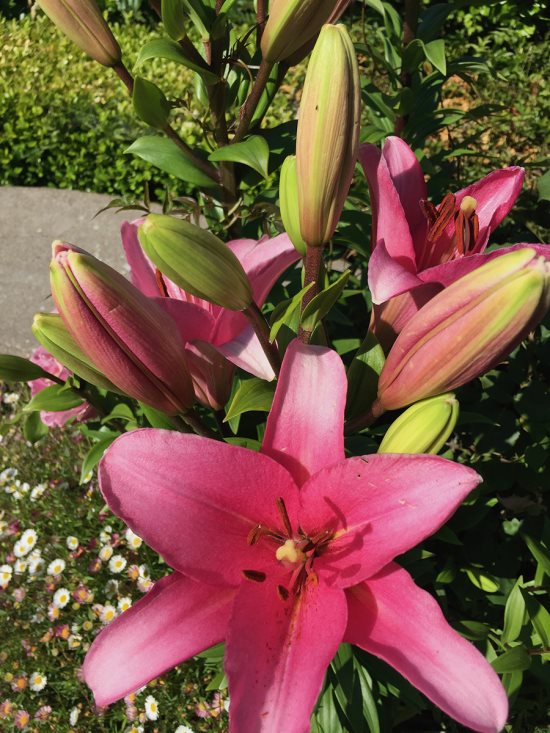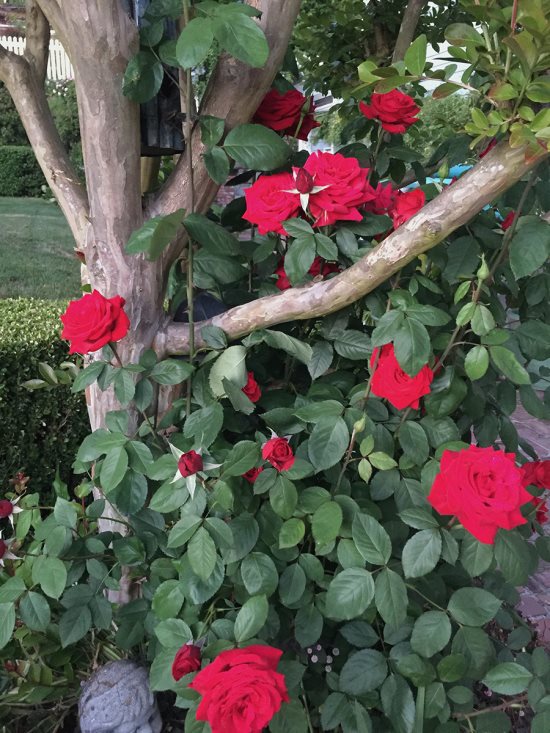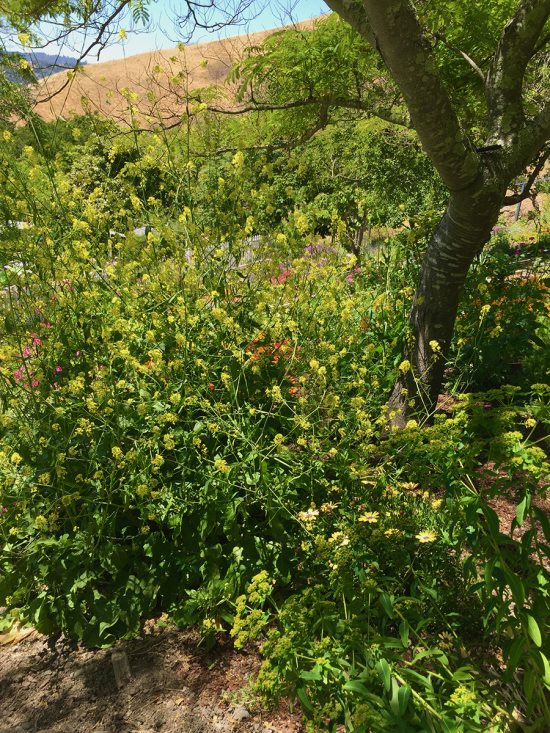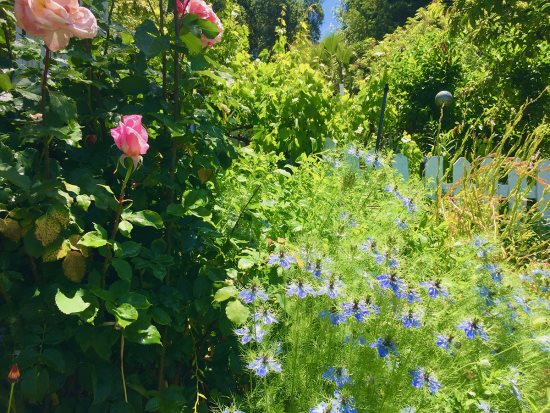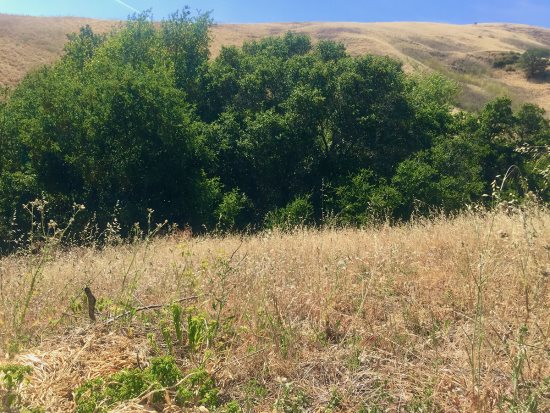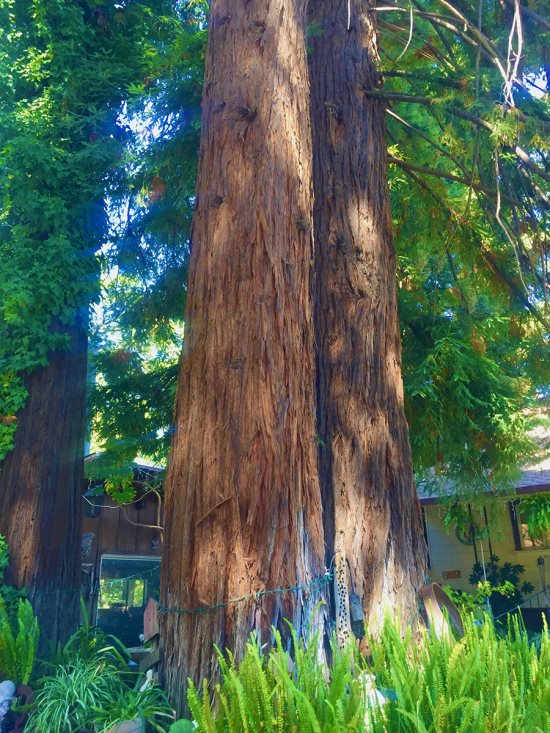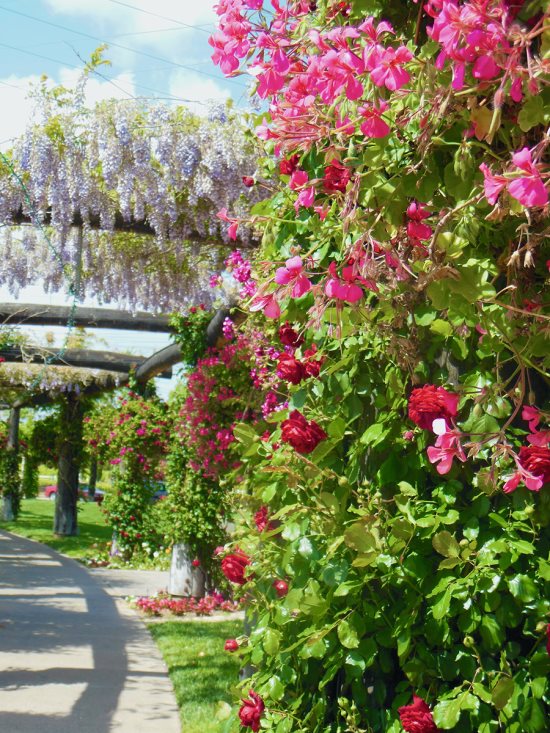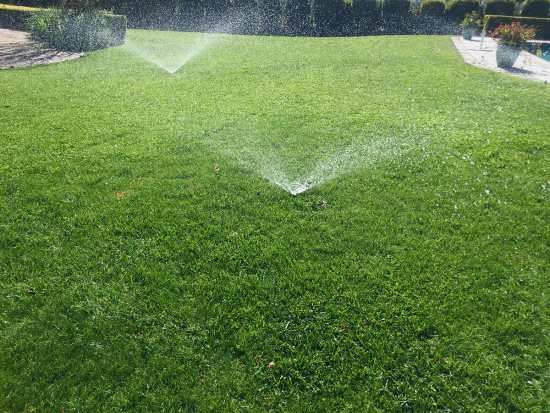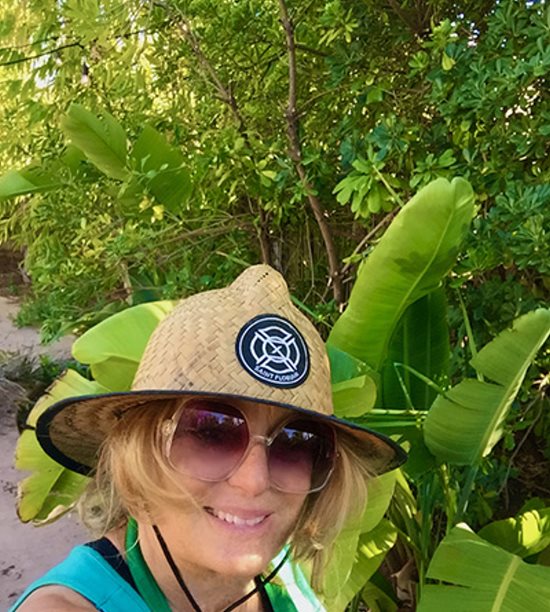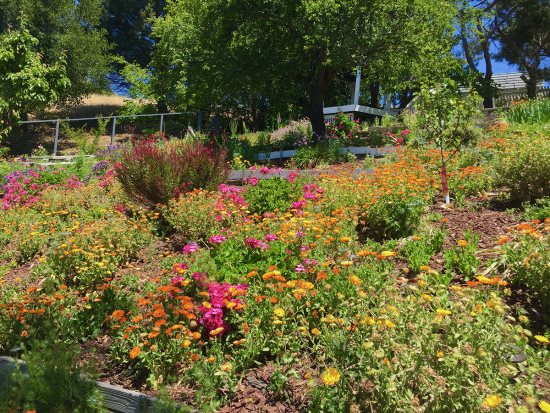 |
|
|
After weeding, this hillside is blooming with statice, gaura, geranium, calendula, and ice plant. Photo Cynthia Brian
|
|
|
|
|
|
Normally the sound of weed-whackers disrupts the tranquility of living the soulful country life, but this year, I am grateful to hear their constant buzzing. With a summer of historical dryness in front of us bringing a looming fire danger, cutting the grasses on hillsides, paths, and in backyards is imperative. I've been working on my property since early February weeding, cutting, pruning, mulching, repairing, and planting in preparation for a hot, dangerous year. You are encouraged to walk through your landscape and make sure you are also ready for whatever may transpire. We want to keep our community picturesque as well as safe. We all play a part in protecting our precious land and lives.
 My articles on creating an Emergency Go-Bag and Wildfire Protection through Landscaping elicited numerous emails and comments (see story links on Page D14). The No. 1 request was to supply a list of plants that would be fire-retardant and fire-resistant.
My articles on creating an Emergency Go-Bag and Wildfire Protection through Landscaping elicited numerous emails and comments (see story links on Page D14). The No. 1 request was to supply a list of plants that would be fire-retardant and fire-resistant.
 When planning a new garden or adding plants to an existing landscape, it is essential to be reminded that no plant is fire-proof. Everything can and will burn if the temperature is hot enough. Also, even if a plant tag indicates that it is fire-resistant, it must be properly maintained, pruned, irrigated, spaced, and positioned in the correct locations to thrive. Plants that have been infested with pests, are too old, or are stressed will be more flammable. Plants that are not nurtured could create a problem for other vegetation. Inspect your botanicals carefully.
When planning a new garden or adding plants to an existing landscape, it is essential to be reminded that no plant is fire-proof. Everything can and will burn if the temperature is hot enough. Also, even if a plant tag indicates that it is fire-resistant, it must be properly maintained, pruned, irrigated, spaced, and positioned in the correct locations to thrive. Plants that have been infested with pests, are too old, or are stressed will be more flammable. Plants that are not nurtured could create a problem for other vegetation. Inspect your botanicals carefully.
 GARDEN ZONES
GARDEN ZONES
 ZONE 1: DEFENSIBLE ZONE
ZONE 1: DEFENSIBLE ZONE
 Plants within 30 feet of a structure need to be considered for fire-retardance. This is Zone 1, the defensible space of your garden which will be able to withstand extreme heat and flying embers. Plants need to be watered thoroughly, trees are preferably deciduous, and the leaves of plants will be moist, fleshy, and broad.
Plants within 30 feet of a structure need to be considered for fire-retardance. This is Zone 1, the defensible space of your garden which will be able to withstand extreme heat and flying embers. Plants need to be watered thoroughly, trees are preferably deciduous, and the leaves of plants will be moist, fleshy, and broad.
 Groundcovers for this area include:
Groundcovers for this area include:
 Lawn grasses
Lawn grasses
 Ajuga
Ajuga
 Isotoma
Isotoma
 Gazania
Gazania
 Alyssum
Alyssum
 Moss
Moss
 Nasturtium
Nasturtium
 Vinca
Vinca
 Dwarf Plumbago
Dwarf Plumbago
 Chamomile
Chamomile
 Zone 1 Perennials include:
Zone 1 Perennials include:
 Acanthus
Acanthus
 Agapanthus
Agapanthus
 Artemisia
Artemisia
 Bergenia
Bergenia
 Canna
Canna
 Dusty Miller
Dusty Miller
 Shasta Daisy
Shasta Daisy
 Chrysanthemum
Chrysanthemum
 Coreopsis
Coreopsis
 Foxglove
Foxglove
 Ferns
Ferns
 Geranium
Geranium
 Daylilies
Daylilies
 Impatiens
Impatiens
 Hosta
Hosta
 Heuchera
Heuchera
 Penstemon
Penstemon
 Pelargonium
Pelargonium
 New Zealand Flax
New Zealand Flax
 Lamb's Ear
Lamb's Ear
 Calla lilies
Calla lilies
 Bird of Paradise
Bird of Paradise
 Zone 1 Shrubs include:
Zone 1 Shrubs include:
 Rose
Rose
 Privet
Privet
 Boxwood
Boxwood
 Camellia
Camellia
 Photinia
Photinia
 Mock Orange
Mock Orange
 Gardenia
Gardenia
 Hibiscus
Hibiscus
 Pittosporum
Pittosporum
 Azalea
Azalea
 Rhododendron
Rhododendron
 Lilac
Lilac
 Viburnum
Viburnum
 Oleander
Oleander
 Zone 1 Vines include:
Zone 1 Vines include:
 Clematis
Clematis
 Trumpet Vine
Trumpet Vine
 Grape
Grape
 Jasmine
Jasmine
 Bower Vine
Bower Vine
 Wisteria
Wisteria
 Zone 1 Trees include:
Zone 1 Trees include:
 Fruit trees
Fruit trees
 Magnolia
Magnolia
 Maple
Maple
 Redbud
Redbud
 Birch
Birch
 Pineapple Guava
Pineapple Guava
 Dogwood
Dogwood
 Crape Myrtle
Crape Myrtle
 Liquid Amber
Liquid Amber
 Ornamental Pear
Ornamental Pear
 Pepper Tree
Pepper Tree
 ZONE 2: FUEL BREAK
ZONE 2: FUEL BREAK
 From 31 feet to 70 feet from a structure, and even further up on slopes, is the greenbelt area which is designed to halt the fire. Plants in this area are the most fire-retardant with low fuels and high moisture content. These plantings can withstand neglect, freezes, droughts, and even insect infestations and still be fire-retardant. Ground covers don't grow over 18 inches. Trees and shrubs have space between them. In general, although succulents and cactus may not survive a fire, they are the best at retarding one.
From 31 feet to 70 feet from a structure, and even further up on slopes, is the greenbelt area which is designed to halt the fire. Plants in this area are the most fire-retardant with low fuels and high moisture content. These plantings can withstand neglect, freezes, droughts, and even insect infestations and still be fire-retardant. Ground covers don't grow over 18 inches. Trees and shrubs have space between them. In general, although succulents and cactus may not survive a fire, they are the best at retarding one.
 Zone 2 Groundcovers include:
Zone 2 Groundcovers include:
 Succulents
Succulents
 Ice plant
Ice plant
 Yarrow
Yarrow
 Artemisia
Artemisia
 Morning glory
Morning glory
 Coreopsis
Coreopsis
 Santa Barbara Daisy
Santa Barbara Daisy
 Wild strawberry
Wild strawberry
 Gazania
Gazania
 Primrose
Primrose
 Osteospermum
Osteospermum
 Clover
Clover
 Verbena
Verbena
 Zone 2 Perennials include:
Zone 2 Perennials include:
 Yarrow
Yarrow
 Dusty Miller
Dusty Miller
 California Poppy
California Poppy
 Iris
Iris
 Gaura
Gaura
 Euphorbia
Euphorbia
 Chrysanthemum
Chrysanthemum
 Coreopsis
Coreopsis
 Statice
Statice
 Candytuft
Candytuft
 Lupine
Lupine
 Red-Hot Poker
Red-Hot Poker
 Sage
Sage
 Yucca
Yucca
 Zone 2 Shrubs include:
Zone 2 Shrubs include:
 Succulents
Succulents
 Cactus
Cactus
 Oleander
Oleander
 Pomegranate
Pomegranate
 Rockrose
Rockrose
 Zone 2 Vines include:
Zone 2 Vines include:
 Virginia Creeper
Virginia Creeper
 Lady Banks Rose
Lady Banks Rose
 Honeysuckle
Honeysuckle
 Nightshade
Nightshade
 Senecio Confusus
Senecio Confusus
 Zone 2 Trees include:
Zone 2 Trees include:
 Carob
Carob
 Strawberry Tree
Strawberry Tree
 Redbud
Redbud
 Honey Locust
Honey Locust
 Chinese Pistache
Chinese Pistache
 California Black Oak
California Black Oak
 Sumac
Sumac
 Yucca
Yucca
 Joshua Tree
Joshua Tree
 GENERAL FIRE-RESISTANT PLANTS
GENERAL FIRE-RESISTANT PLANTS
 Although no plant is 100% fire-proof, these plants are less likely to burn. Several are already listed for Zones 1 and 2.
Although no plant is 100% fire-proof, these plants are less likely to burn. Several are already listed for Zones 1 and 2.
 Bulbs (tulips, daffodils, iris, hyacinth, freesia, etc. Cut stalks to the ground when leaves are dry)
Bulbs (tulips, daffodils, iris, hyacinth, freesia, etc. Cut stalks to the ground when leaves are dry)
 California redbud
California redbud
 Sage
Sage
 Penstemon
Penstemon
 Heather
Heather
 Fuchsia
Fuchsia
 Columbine
Columbine
 Thyme
Thyme
 Poppy
Poppy
 Wild strawberry
Wild strawberry
 Common yarrow
Common yarrow
 French lavender
French lavender
 Lantana
Lantana
 Lilac
Lilac
 Coreopsis
Coreopsis
 Ajuga
Ajuga
 California lilac
California lilac
 Society garlic
Society garlic
 Jasmine
Jasmine
 Periwinkle
Periwinkle
 Alliums
Alliums
 Dianthus
Dianthus
 Yellow or Purple Ice Plant
Yellow or Purple Ice Plant
 Creeping Phlox
Creeping Phlox
 Lamium
Lamium
 Sedum
Sedum
 Succulents
Succulents
 Veronica
Veronica
 Armeria
Armeria
 Agapanthus
Agapanthus
 Trumpet Vine
Trumpet Vine
 Daylily
Daylily
 Heuchera
Heuchera
 Hosta
Hosta
 Red-Hot Poker
Red-Hot Poker
 Lupine
Lupine
 Delphinium
Delphinium
 Echinacea
Echinacea
 Lamb's ear
Lamb's ear
 Yucca
Yucca
 Rose
Rose
 Salvia
Salvia
 Evening primrose
Evening primrose
 Daphne
Daphne
 Boxwood
Boxwood
 Rhododendron
Rhododendron
 Spirea
Spirea
 Dogwood
Dogwood
 Mock orange
Mock orange
 Azalea
Azalea
 Currant
Currant
 Viburnum
Viburnum
 Aloe
Aloe
 Primrose
Primrose
 Candytuft
Candytuft
 African Daisy
African Daisy
 Calendula
Calendula
 TREES:
TREES:
 Horse Chestnut
Horse Chestnut
 Liquid Amber
Liquid Amber
 Honey Locust
Honey Locust
 Crabapple
Crabapple
 Purple Robe Locust
Purple Robe Locust
 Fruit Trees (varieties of cherry, plum, pear, peach, apricot, pomegranate, fig)
Fruit Trees (varieties of cherry, plum, pear, peach, apricot, pomegranate, fig)
 Black Oak
Black Oak
 Hawthorne
Hawthorne
 Birch
Birch
 Aspen
Aspen
 Poplar
Poplar
 Maple
Maple
 Manzanita (prune without deadwood)
Manzanita (prune without deadwood)
 Walnut
Walnut
 California Bay Laurel
California Bay Laurel
 California Pepper
California Pepper
 Remember that deciduous plants are less flammable than evergreen. Gray and silver plants have a high mineral and ash content which makes them more fire-resistant. Vegetation with needles or fine, thin leaves is flammable. The more stored moisture a plant has, the more it can withstand a fire. Use less-flammable types of mulch, such as gravel or decorative rock, or a combination of wood bark mulch and decorative rock to dress your garden, retain moisture, and deter weed growth.
Remember that deciduous plants are less flammable than evergreen. Gray and silver plants have a high mineral and ash content which makes them more fire-resistant. Vegetation with needles or fine, thin leaves is flammable. The more stored moisture a plant has, the more it can withstand a fire. Use less-flammable types of mulch, such as gravel or decorative rock, or a combination of wood bark mulch and decorative rock to dress your garden, retain moisture, and deter weed growth.
 To burn, fires need fuel. By removing debris, planting and maintaining a fire-retardant and fire-resistant landscape, cutting down dead trees, thinning dried branches, spacing, pruning, watering, and keeping trees away from roofs, you will dimmish the chance of ignition, lower fire intensity, and reduce the spread of a blaze. Your home will have a better chance of surviving a wildfire.
To burn, fires need fuel. By removing debris, planting and maintaining a fire-retardant and fire-resistant landscape, cutting down dead trees, thinning dried branches, spacing, pruning, watering, and keeping trees away from roofs, you will dimmish the chance of ignition, lower fire intensity, and reduce the spread of a blaze. Your home will have a better chance of surviving a wildfire.
 Best of all, you can still create a gorgeous oasis where you can entertain, relax, and socialize.
Best of all, you can still create a gorgeous oasis where you can entertain, relax, and socialize.
 Firewise volunteers are available to offer advice in neighborhoods. The Orinda Firewise Council supports and educates the public about wildfire resilience. They are seeking landscapers and nurseries to assist with communicating ways in which homeowners can become more wildfire safe by making their property more fire-resistant. To work together with them to empower and beautify the community, go to https://www.orindafirewisecouncil.org/contact-us
Firewise volunteers are available to offer advice in neighborhoods. The Orinda Firewise Council supports and educates the public about wildfire resilience. They are seeking landscapers and nurseries to assist with communicating ways in which homeowners can become more wildfire safe by making their property more fire-resistant. To work together with them to empower and beautify the community, go to https://www.orindafirewisecouncil.org/contact-us
 Website: https://www.orindafirewisecouncil.org
Website: https://www.orindafirewisecouncil.org
 You don't want fires to crawl fueled by unkempt low-lying vegetation, high grasses, or mounds of leaves. Get out the weed whackers and go to work. Be fire safe and enjoy a wonderful summer.
You don't want fires to crawl fueled by unkempt low-lying vegetation, high grasses, or mounds of leaves. Get out the weed whackers and go to work. Be fire safe and enjoy a wonderful summer.
 Happy Gardening. Happy Growing. Congratulations to the graduates and Happy Father's Day to all the great dads.
Happy Gardening. Happy Growing. Congratulations to the graduates and Happy Father's Day to all the great dads.
 Links to Lamorinda Weekly "Go Bag" and "Firewise Landscaping" stories:
Links to Lamorinda Weekly "Go Bag" and "Firewise Landscaping" stories:
 www.lamorindaweekly.com/archive/issue1507/Packing-an-emergency-Go-Bag.html
www.lamorindaweekly.com/archive/issue1507/Packing-an-emergency-Go-Bag.html
 www.lamorindaweekly.com/archive/issue1507/Digging-Deep-with-Goddess-Gardener-Cynthia-Brian-Wildfire-protection-through-landscaping.html
www.lamorindaweekly.com/archive/issue1507/Digging-Deep-with-Goddess-Gardener-Cynthia-Brian-Wildfire-protection-through-landscaping.html
|
Cynthia Brian working to make the garden
fire-safe.
Cynthia Brian, The Goddess Gardener, is available for hire to help you
prepare for your garden. Raised in the vineyards of Napa County,
Cynthia is a New York Times best-selling author, actor, radio
personality, speaker, media and writing coach as well as the Founder
and Executive Director of Be the Star You Are!r 501 c3. Tune into
Cynthia's StarStyler Radio Broadcast at
www.StarStyleRadio.com.
Buy copies of her books, including, Chicken Soup for the Gardener's
Soul, Growing with the Goddess Gardener, and Be the Star You Are!
www.cynthiabrian.com/online-store. Receive a FREE inspirational
music DVD and special savings.
Hire Cynthia for writing projects, garden consults, and inspirational
lectures.
Cynthia@GoddessGardener.com
www.GoddessGardener.com |

